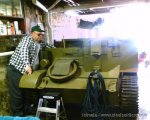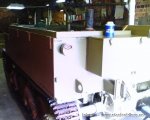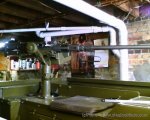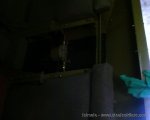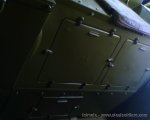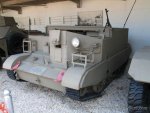The above British vehicle is either a T16 Made in the US by ford OR perhaps an Oxford or Windsor Carrier.
There are basically three classes of "Bren Carrer"
1st Gen, Non universal Carriers. Each hull was designed to a specific purpose:
Bren Carrier, Scout Carrier, MMG/Vickers Carrier, Mortar Carrier, etc
Quick ID factors are, 3 road wheels on horstman suspensions and varying details on the front hull configuration. Bren and Scut carriers are cut down on opposite sides, MMG carriers have a different front protrusion for the MMG, and other details for the rear hull and stowage.
2nd Gen Universal Carriers often called a Bren carrier.
Quick ID factors are, 3 road wheels on horstman suspensions just like the above models but the hull is universal with extra fittings in the form of stoage boxes, brackets and bins added to set it up for the specific role of OP, Bren, MMG, Mortar carrier. there were two Marks of Carriers with different arrangements on hull configurations for fenders and the like. The Mk1s were bolted/rivited, the Mk2s were welded.
3rd Gen Universal Carriers
Quick ID factors are, 4 Roadwheels on a horstman suspension (2 bogies with 2 wheels each) and a generic hull usually setup for general purpose use. I'm not sure if there was ever a MMG or OP version of the T16/Windsor/Oxford carriers. T16s ditched the warp steering method and installed two brake levers. This was easier at slow speeds but harder to control at high speeds. Carriers could get to 30mph on paved surfaces and yanking back on a tiller steering lever could cause some nasty oversteer. The larger 3rd Gen carriers were better able to tow AT guns but the larger AT guns like the 17 pounder were out of it's range so they were relegated to 6 pounders or general carrier duty. They were very rare as the war ended as they were coming into service. Some saw after the war service but their build numbers were QUITE small.
There was also the Loyd Carrier which had a front axle, a more prominent engine bay and a fully open rear back. These were used more routinely as general purpose rough terrain tow vehicles and logistics vehicles. There was a version equipped with battery service gear for charging and supplying fresh 6 and 12 volt lead acid batteries to vehicles and units as the British tended to use those instead of dry cells for radios.
The Universal Carriers were far more common with Canadian, British, Australian and New Zealand building a total of around 300,000 if I recall correctly.






